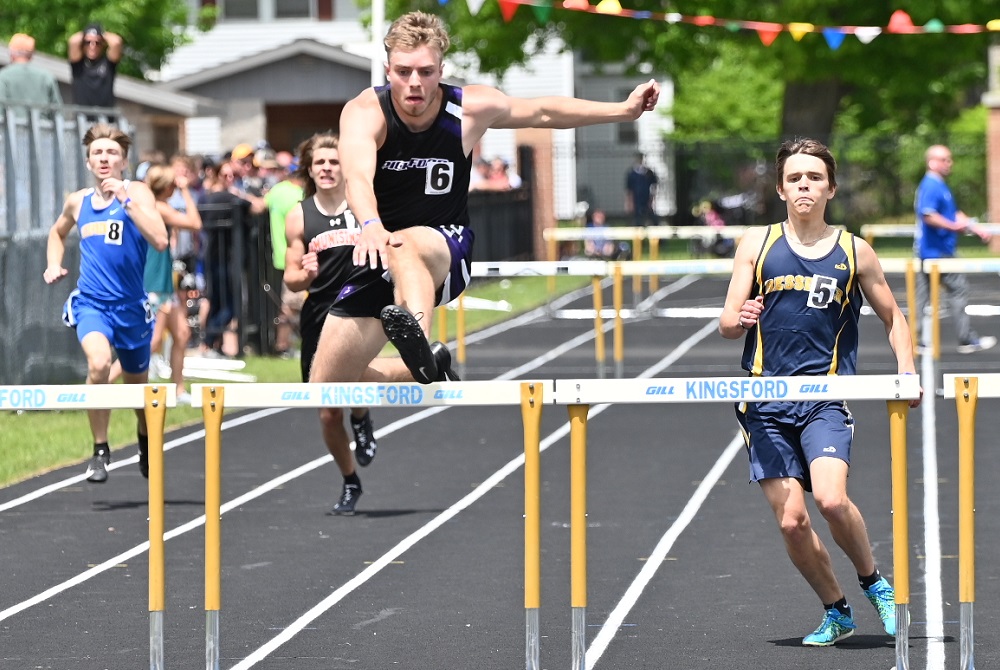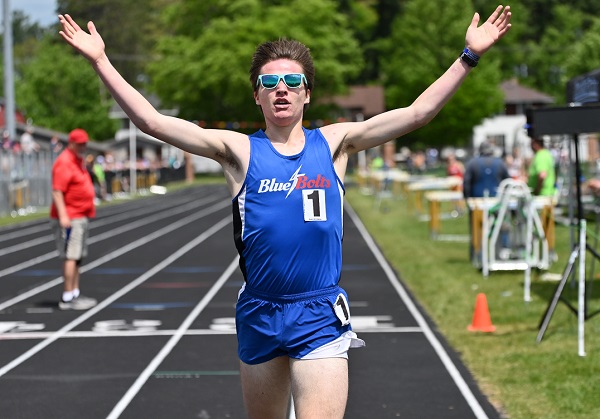
Pickford Hangs On with Win in Final Event to Secure UPD3 Championship
By
John Vrancic
Special for MHSAA.com
June 5, 2022
KINGSFORD — They were tested, but the Pickford boys came through with their first Upper Peninsula Division 3 track & field championship in a decade Saturday.
Pickford scored 91 points, followed by Munising with 82 and 2021 champ Dollar Bay at 56. Pickford was runner-up to Dollar Bay last season, with this team title its first since 2012.
The Panthers secured the title by winning the 1,600-meter relay in 3 minutes, 37.83 seconds.
“We were up by one point going into the 1,600 relay,” said Panthers’ coach Garde Kangas. “You can’t get much closer than that. One kid who’s a part of all our relays couldn’t be here because he had to go to a funeral. We had some kids step up. In long jump, we were seeded fourth or fifth and our guy (Noah Barowski) got second, and we ran our best time all year in the 1,600 relay.”
Junior Caden Awbrey provided the Panthers with a first in the 300-meter hurdles in 41.98 seconds and a second in the 110s (17.24).
“I really liked the start, but got a little sloppy in the end,” he said. “About halfway through I started clipping the hurdles (in the 300s). Although, this is something I can build on. I need to work on my form, and that takes time.
 “Overall, I think the day has gone pretty well. Our 1,600 relay is fast and our 3,200 is solid. We were missing some people and still PR’d.”
“Overall, I think the day has gone pretty well. Our 1,600 relay is fast and our 3,200 is solid. We were missing some people and still PR’d.”
Dollar Bay senior Nik Thomas set two UPD3 meet records on a sunny and warm day. He was clocked at 4:25.91 in the 1,600 and 10:05.59 in the 3,200, topping the previous-bests of 4:28.68 and 10:08.51 by Bessemer’s Uriah Aili three years ago. Thomas also won the 800 (2:01.27) and placed fourth in the 400 (53.03) on Saturday.
Ewen-Trout Creek senior Jonah Nordine was runner-up in all three races Thomas won, at 2:06.39, 4:40.3 and 10:26.51, respectively.
Munising was led by the Peramaki brothers. Micaiah won the 100 (11.52), 200 (23.7) and 400 (51.98) and discus at 127 feet, 4 inches, and Josiah took pole vault at 13 feet, 4 inches and placed third in long jump (18-4¾).
North Central junior Luke Gorzinski anchored the winning 400 relay (45.34) and 800, clocked at a school-record 1:35.31, and was runner-up in the 100 (11.57) and 200 (23.94).
“Our handoffs absolutely went real well,” he said. “I’ve had more time to work on those now that baseball is over. This is pretty awesome. We’ve been working toward this all season.”
Junior Trent Naser provided the Jets with a victory in the 110 hurdles (16.76) and a third in the 300s (42.78).
PHOTOS (Top) Pickford's Caden Awbrey (6) leads the 300 hurdles on the way to winning the race Saturday. (Middle) Dollar Bay's Nikolas Thomas celebrates his win in the 1,600, one of his three championships at the meet. (Click for more from Cara Kamps/Run Michigan.)

Track Gaining Speed Toward Future with Electronic Starting Devices
By
Steve Vedder
Special for MHSAA.com
May 23, 2023
Aubrey Greenfield thinks it might be the perfect time to reevaluate 130 years of tradition.
For a number of reasons, from technical to personal, the Oxford senior sprinter believes it makes sense for the crack of a starting pistol to be eliminated from high school track meets.
Because track meets would benefit in various ways from lowering costs to easier setup at meets to the human factor of competitors not having to flinch at the crack of a pistol shot, Greenfield believes the sport has a chance to embrace new technology – electronic starting devices (ESD).
In essence, an ESD replaces the starting pistol with a light flash, tone sound or both to begin a race.
"High school sports should put the athlete first," Greenfield said. "We should promote sports, and eliminating starting pistols promotes health in terms of PTSD or trauma for athletes and spectators and that would be good. I would like to think people would say that's a good idea."
In fact, Greenfield would go as far as to say if there was not an implementation of electronic starting devices, many of her teammates would have considered giving up the sport.
"If it's something that helps us compete safely, we're all for it," she said.
Greenfield's opinion apparently is spreading. Michigan High School Athletic Association senior assistant director Cody Inglis said the use of ESD makes it both affordable for meet starters and sensible for athletes and fans to rethink the use of starting pistols. While the MHSAA is not mandating electronic starting devices, it does promote the use of what Inglis calls "emerging technology." He notes that ESD are becoming the norm for organizations such as USA Track & Field, the NCAA and an increasing number of high schools.
 "I think we have to embrace new technology, and we think this will be something that takes hold," Inglis said.
"I think we have to embrace new technology, and we think this will be something that takes hold," Inglis said.
A key part of embracing ESD is the human element. The tragic Oxford High School shooting Nov. 30, 2021, that took the lives of four students while injuring seven others should not be relived even for a fleeting instance at a high school sporting event. Oxford athletic director Tony DeMare said the school began using ESD at every meet, including the MHSAA Lower Peninsula Division 1 Finals last June. He said that decision was embraced by virtually all schools Oxford encountered.
"We were very convinced that the alternative (of ESD) would promote a healthy attitude," DeMare said. "We were overwhelmed with the positive response. If a school was on the fence about it or might not be for it, I think we've started to see the tide turn in favor of people willing to listen and learn about electronic starting devices."
Inglis said the MHSAA is acutely aware of what the crack of a starting pistol can mean to athletes and fans.
"It's unimaginable what Oxford went through, and this is a small way we can help," he said. "We look at a (starting pistol) and think, ‘Could we do something else?’ It's a way of helping to solve a problem."
Over the last several years, the MHSAA has embraced finding an alternative to starting pistols. Inglis noted the discussion started with the cost and diminishing availability of 32-caliber ammunition that meet starters use. A box of ammunition, if it can be found, is around $75 a box.
In addition to cost, there is potential damage from excessive exposure to 150-plus decibels of sound generated by the traditional 32-caliber blanks. Medical studies show damage to ears caused by decibel levels above 120 dB.
The tragedy at Oxford accelerated the conversation.
Inglis said the cost of ESD can be likened to a school sinking money into artificial surfaces at football fields. Yes, there is a great cost at first, but over time money is ultimately saved. An ESD system itself ranges between $200 and $500. Speakers also may need to be purchased, but with ESD starting events like the 800 and 1,600-meter relays positioned near the outside lanes 8, 7, 6 and 5 would result in improved hearing by athletes at the start of a race.
There is one challenge with ESD that track administrators are working to overcome – lighting conditions that lessen the ability to see the ESD’s LED light or strobe when the button is pressed by a starter to begin a race. But that vision difficulty resulting from clear blue skies and backgrounds of setting suns can be substantially improved by incorporating a black background with an ESD – something as simple as a starter holding up black cardboard behind the lighting mechanism at the start of an event.
Inglis said when all factors are considered, the use of ESD makes sense.
 "With the climate we live in nowadays, no lookalike guns is good," he said. "We're not mandating this. But people are saying this is affordable."
"With the climate we live in nowadays, no lookalike guns is good," he said. "We're not mandating this. But people are saying this is affordable."
While switching to ESD would break 130 years of tradition, the timing could be a step forward, said Jeff Hollobaugh, co-author of the book "The Fleet Feet of Spring: Michigan's High School State Championships in Track & Field." He said while no definitive answer is possible, it's likely starting pistols were used at the inaugural state meet at the Jackson Fairgounds in 1895. The meet, which included events like tossing a 16-pound shot put, bike races and a 100-meter sprint, was sponsored by the Michigan Interscholastic Athletic Association (a predecessor to the MHSAA) and comprised mostly of the state's larger schools.
Hollobaugh's sentiments echo what many involved in today's high school track & field believe in terms of making a transition from starting pistols to electronic starting devices.
"It's a change, not necessarily good or bad, just different," he said. "It's not a drastic change, but it will take some getting used to. But it is the future. In the end, we'll all be fine."
DeMare believes the future of high school track will definitely include ESD.
"Our desire is that the practicality and sensibility of this will overcome the alternative," he said. "I think we'll see the automation and electronics taking hold of certain elements in track, and people will embrace it."
PHOTOS (Top) Runners watch official Bertha Smiley as they prepare to begin a race during last season's Lower Peninsula Division 1 Finals at Rockford. (Middle) An electronic starting device provided by VS Athletics was used to start those races. (Below) Smiley sets to begin an event. (Photos provided by David Kuderka/VS Athletics.)

